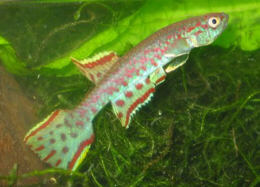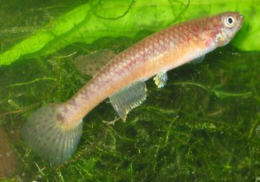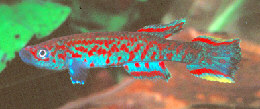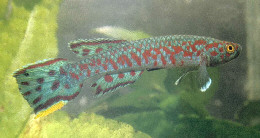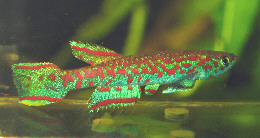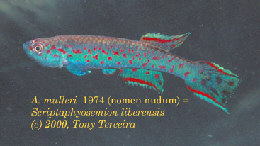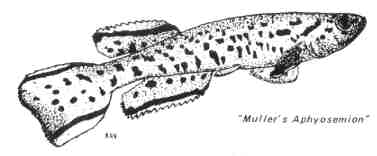Scriptaphyosemion liberiense (Boulenger 1908)
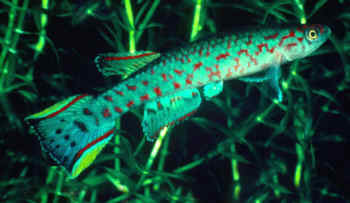
Firestone Plantation, distributed in the BKA. BKA photo.
| Meaning of Name |
After Liberia, the country of origin. |
|||||||
| First Description |
Boulenger G.A. 1908. Description of two new Cyprinodontid fishes from west Africa. Annals & Magazine of Natural History (8): ii,: p 30. |
|||||||
| Size |
4.5 cm |
|||||||
| Meristics |
|
|||||||
| Karyotype |
n = 21, A = 22 (Scheel 1968; Vandermissen, Etzel & Berkenkamp 1980) |
|||||||
| Sub-Genus |
|
|||||||
| Group |
liberiense |
|||||||
| Synonyms |
|
|||||||
Populations
|
|
|||||||
| Type Locality |
Monrovia area, Sierra Leone. |
|||||||
| Distribution |
Southeast Sierra Leone across the border with Liberia. Inhabits the Moa & Sewa River drainages in Sierra Leone & the Lofa, Mano & Saint Paul River drainages in Liberia. |
|||||||
| Habitat |
Coastal rainforest pools, swamps & brooks. |
|||||||
| Distinguishing Characteristics | ||||||||
| Colour/Pattern Variability | High | |||||||
| History |
Boulenger described this species in 1908 from 2 females presented to him by Arnold who found them ( 3 specimens in all ) in a bag of E.dageti imported from Monrovia in 1908. This incidentally, was the first recorded import for E.dageti. Boulenger gives the following collectors / locations in his 1915 Catalogue.
Pellegrin, in 1934, reports Script.liberiense from Man, western Ivory Coast although Scheel considered these may have been maeseni. He also reported liberiense from Kindia although Scheel considered these may have been geryi or roloffi. This area is also in the distribution area of Script. cauveti. In 1942 Schulz reported them being collected at Bromley & Du River close to Monrovia. Daget reported the species being collected from Mount Nimba in 1948 & from Banfora in 1960. The Banfora fish were thought to be maeseni although Banfora is in the distribution area of Script. banforense. In 1965 Clausen collected 4 specimens of liberiense but these died in transit to Scheel. The Monrovia population was distributed in the BKA by Species Import Committee in May 1980. History of the synonym Aphyosemion calabaricus Ahl 1935 In 1935 Ahl described this sp. from
aquarium kept individuals from unknown origin. These specimens were
provided by F.Mayer of Hamburg who, in turn bought them from O.Winklemann
of Altona. The professional collector who caught them from the wild
told Winklemann that he caught them in Calabar, Niger Delta area. This
information is regarded as incorrect. History of the synonym Roloffia melantereon Fowler 1950. In 1950 Fowler described Epiplatys melanteron from 3 specimens collected by Matlock near Robertsport, western Liberia. The largest specimen collected measured only 25 mm. Etzel researched the area & concluded that only Script.liberiense & Script.brueningi are native to this collection area. History of the synonym Roloffia fredrodi Vandermissen, Etzel & Berkenkamp 1980 Collected by Fred Wright & Rod Roberts (BKA) in 1980. The name was taken from both Christian names. The type locality was Goboru, Sierra Leone. |
|||||||
| Breeding Notes |
Regarded as an easy species to breed. Eggs can be taken from the mop & water incubated. Hatching occurs about 18-21 days although some breeders found they took a little longer. Growth rate can be a little slow with sexual maturity taking about 5-6 months. Scheel reported in ROTOW 1 that the species had been in captivity since 1935. Breeders had observed that egg incubation periods if left in an aquarium could be delayed by up to 'several weeks' instead of the usual '10 - 12 days'. It was also observed that eggs incubated in clean water without peat or mud did not develop lengthened incubation periods. |
|||||||
| Diameter of Egg | ||||||||
| Remarks |
|
